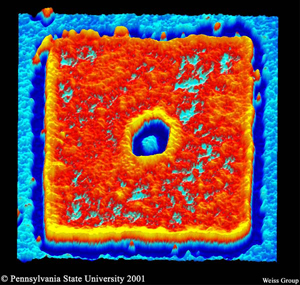My friends at crnano.org, Mike Treder and Chris Phoenix, recently posed the question "No Replicators Until 2075?" Their ~260 words are the best explanation I've read regarding this issue.
Mike sums it up nicely "If too many people are convinced that we won't see these things for 50 or 100 years, it's almost certain that the world will be caught unaware, and then reactions to such a transformative and disruptive new technology could be chaotic and catastrophic. Much better that we start studying and preparing now, instead of putting it off."
In December 2006, Mike and Chris celebrated the four-year anniversary of CRN's founding. In that short time they have come a long way towards helping stakeholders understand the issues surrounding MM. I support their mission.
Tuesday, January 2, 2007
Picture of the day

A field emission scanning electron microscopy image showing a ~30 nm gold dot formed in the center of a hollow gold parent structure supported on an oxidized Si substrate. This nanostructure was fabricated by a 'molecular ruler' resist process developed to extend the range of conventional nanolithography techniques.
Acknowledgements: A. Hatzor & B. A. Mantooth.
As with the previous picture, I will post the others in this series over time. To see it all now, visit the Nanotechnology Now Gallery.
"We focus on gaining atomic-scale understanding and control of materials properties. We do this by exploring, probing, and manipulating interactions and dynamics at surfaces and interfaces. We use and extend scanning tunneling microscopy to explore the surface structures, motion, and perturbations due to adsorbed atoms and molecules and due to surface features such as substrate steps and defects. We locate, study, and try to exploit the regimes in which our intuition based on macroscopic measurements breaks down. We are exploring the phenomena to be used, the ground rules, and the ultimate limits in nanometer-scale electronics and storage. Our microscopes serve not only as probes, but also allow us to manipulate matter on the atomic scale. We can thus interrogate the properties of uniquely configured atomic-scale structures. This has required the development of new tools with atomic-scale views of the surface. One new effort in our group looks at how we can bridge the gap between conventional optical microscopies and scanning probe microscopies."
—Paul S. Weiss, Professor of Chemistry, Pennsylvania State University. Weiss Group Featured Images
Quote of the day
"It's a brave new world out there," Richard Smalley, Ph.D., Rice University professor of nanotechnology said. "What's new is the notion that we can actually build new nano-objects that have never existed before that increase our arsenal of capabilities." (referring to the NCI Alliance for Nanotechnology in Cancer initiative)
Dr. Smalley passed away in October 2005, at the age of 62. Smalley is best known as co-discoverer of the buckyball. In recent years he had been actively involved in promoting nanotech-enabled energy solutions, and was a vocal, articulate proponent.
"Colleagues and scientific leaders say it is hard to overestimate the role Smalley played in founding and fostering the development of nanotechnology, one of the most important and exciting new areas of scientific inquiry to arise in the past quarter century." Rice media release
To learn more about nanotech-enabled medicine, visit the NanoTumor Center
Dr. Smalley passed away in October 2005, at the age of 62. Smalley is best known as co-discoverer of the buckyball. In recent years he had been actively involved in promoting nanotech-enabled energy solutions, and was a vocal, articulate proponent.
"Colleagues and scientific leaders say it is hard to overestimate the role Smalley played in founding and fostering the development of nanotechnology, one of the most important and exciting new areas of scientific inquiry to arise in the past quarter century." Rice media release
To learn more about nanotech-enabled medicine, visit the NanoTumor Center
Definition change
As I said in the last post, it’s hard to get your hands around MM. To be more accurate, it’s hard to wrap your mind around MM.
With that in mind, here is a short explanation on how the term "nanotechnology" has a different meaning than it did back when Dr. K. Eric Drexler first used it to describe what we now call molecular manufacturing (MM).
The term "nanotechnology" evolved (*) over the years via terminology drift to mean "anything smaller than microtechnology," such as nanoscale powders and other things that are nanoscale in size, but not referring to products that have been purposefully built from nanoscale components.
Today, when poeple talk about "nanotechnology" they are usually referring to the new definition, not MM.
Read more about today’s nanotechnology products at the Nanotechnology Now Current Uses page.
(*) I say "evolved" rather that the possibly more accurate term "hijacked" since there remains some debate. Many argue that old-economy industries such as advanced materials companies are responsible for the change in meaning.
With that in mind, here is a short explanation on how the term "nanotechnology" has a different meaning than it did back when Dr. K. Eric Drexler first used it to describe what we now call molecular manufacturing (MM).
The term "nanotechnology" evolved (*) over the years via terminology drift to mean "anything smaller than microtechnology," such as nanoscale powders and other things that are nanoscale in size, but not referring to products that have been purposefully built from nanoscale components.
Today, when poeple talk about "nanotechnology" they are usually referring to the new definition, not MM.
Read more about today’s nanotechnology products at the Nanotechnology Now Current Uses page.
(*) I say "evolved" rather that the possibly more accurate term "hijacked" since there remains some debate. Many argue that old-economy industries such as advanced materials companies are responsible for the change in meaning.
Subscribe to:
Comments (Atom)









